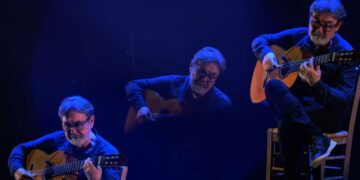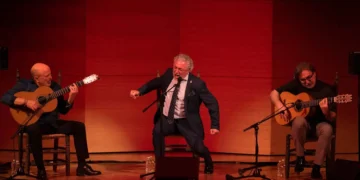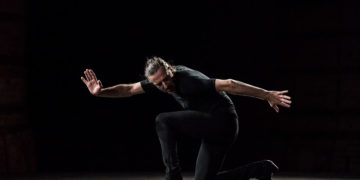|
“El el Bar Iberia” – |
|
|
SPECIAL BIENAL DE FLAMENCO DE SEVILLA 2008 Text: Estela Zatania Cante: Segundo Falcón. Guitar: Paco Jarana. Second guitar: Manuel de la Luz. Percussion: Manuel Muñoz “el Pájaro”, Paco González. Chorus and palmas: Los Mellis. String quartet. Arrangements: Jesús Cayuela. A voice and a guitar. And a few instruments too, but the voice of Segundo Falcón, and the guitar of Paco Jarana are the basis for this elegantly constructed show. It’s not that what they do is easy; both are maestros in their respective fields. It’s the moderation and humility with which they deliver the goods, the extreme attention to detail, the respect for the art which they so clearly love. With that starting point, these two men offer their contemporary perspective, firmly anchored in the most classic flamenco. The “bar” alluded to in the title refers to a flamenco gathering place in Seville that just came into being in 1970, the dawn of the new age of flamenco for the generation of Falcón and Jarana, and for others, the end of an era. From that decade of not only artistic, but also political transition, comes this new type of cante recital. No longer do singers and guitarists make it up as they go along. Now, singers mount a polished product, like any major dance company. A half-century ago the most popular flamenco singers would tour the country with their own variety shows; now it’s a highly sophisticated format for an age that longs for sophistication above all else. The recital is divided in two parts, which are really four. First, Paco Jarana, alone with his guitar for soleá and siguiriyas, followed by a series of instrumentals with second guitarist, two percussionists and a string cuartet. Then, Segundo Falcón, like the guitarist, begins in the classic vein before guiding our ears to more musical pieces. Jarana’s solos recall a certain gentleman from Pamplona who was so fond of broad beans (las habas), that it earned him a nickname. According to Sabicas, the first great flamenco guitar soloist, you had to play twenty years for cante, and twenty for dance in order to devote yourself to solo guitar. Assuming both tasks can be accomplished simultaneously, Jarana has more than paid his dues, and this is reflected in compositions with user-friendly compás and a powerfully flamenco fragrance, no matter how musical they are. When the guitar is cooking on high heat por bulería, Segundo Falcón arrives on stage, pushing the tempo down, and imposing the compás of soleá with his Triana melodies and a sensual delicate delivery, without letting the tension slacken. The entire recital makes use of these natural transitions that reject programmed applause. We gently slide into caña, a cante desperately in need of updating, and no one better than this singer to do it. The string quartet, chorus, palmas and percussion join in, and we are eased into a rich selection of cantiñas, from alegrías de Córdoba and Cádiz, to the cante of the Mirris. Pain-free evolution, based on knowledge and boundless dedication. The liviana, another cante Segundo snatches from the jaws of obsolescence, with siguiriya and toná liviana, although the high-gear velocity of the accompaniment and the percussion lend an uncomfortable urgency. For the home stretch it’s malagueñas, and “a creation of the great Pepe Pinto”, which the singer dedicates to his wife, ending up with a fandango of Toronjo. These are exquisitely constructed and executed arrangements, a very personal kind of ‘fusion’ by a singer whose musical knowledge is enhanced by artistic honesty and good taste, not to mention the outstanding guitar of his friend Paco Jarana. |
Descubre más desde Revista DeFlamenco.com
Suscríbete y recibe las últimas entradas en tu correo electrónico.


 XV BIENAL DE FLAMENCO DE SEVILLA
XV BIENAL DE FLAMENCO DE SEVILLA 

























